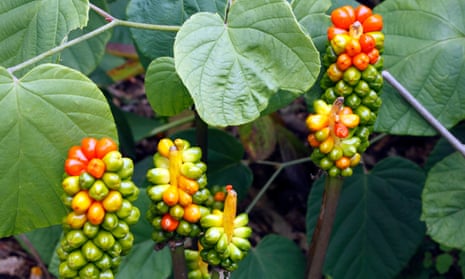The post-pandemic years have seen an absolute explosion of interest in exotic aroids. With their dramatic, architectural foliage and dazzling leaf patterns, they have sold for tens of thousands of pounds online – not even rooted plants, but individual stem cuttings. This has caused an unprecedented boom, with growers in places like Indonesia and Thailand all rushing to propagate them to satisfy a surging global market. Yet while so many in the west have been clamouring for these rare plants that originate on the other side of the world, we have somehow managed to overlook the spectacular hardy aroids that grow literally outside our back doors here in the UK.

Hardy aroids look so remarkably like their tropical cousins that in a botanical lineup even I – a south-east Asian botanist – would find it tricky to tell them apart. But they are often a tiny fraction of the cost and much easier to grow. Just stick them in the ground in moist, shady spots and for most of these seasonal bulbs that’s all you will need to do.
Compare that with the tropical forms that require constant, year-round warmth and artificial lighting through winter, and this can also make them an expensive business. Not to mention that much of the patterning on the tropical types comes from unstable human-induced variegation, meaning the mutant white sections often scorch even in the most ideal conditions. The natural variegation on the hardy forms, however, displays no such finickiness.
So which varieties should you be looking for? Well, for starters there’s Arum italicum ‘Pictum’, with glossy deep green leaves patterned with the most intricate webbing, like silver embroidery. It looks very much like the super-trendy tropical genus Syngonium but will rapidly colonise any shady spot with well-drained soil, giving you a carpet of exotic foliage that magically appears in winter when everything else retreats underground. Come the summer, the same plants offer triffid-like flowers and torches of shiny red berries. Arum creticum swaps the leaf pattern for much larger, creamy yellow flowers in the spring, with a hauntingly fresh scent.
Then there’s the remarkable Amorphophallus – a close relative of the giant Titan arum, whose 8ft-tall flowers are the wonder of tropical glasshouses in botanic gardens around the world. Amorphophallus konjac is a bone-hardy cousin that can be grown in any woodland garden. Each plant produces only a single leaf that branches out into a parasol of leaflets to create the appearance of a mini tree. Even the leaf stem has evolved a speckled appearance to mimic the lichen that grows on jungle trees to fool herbivores into thinking they are unappetising woody trunks.
Just like arums, all they need is moist, well-drained soil in a shady spot. Plant the forms around 15cm deep and they will pop up again year after year in exchange for little more than the occasional watering in particularly dry summers.
Follow James on Twitter @Botanygeek
The captions were amended on 29 September 2022. An earlier version had each appearing with the wrong plant.
